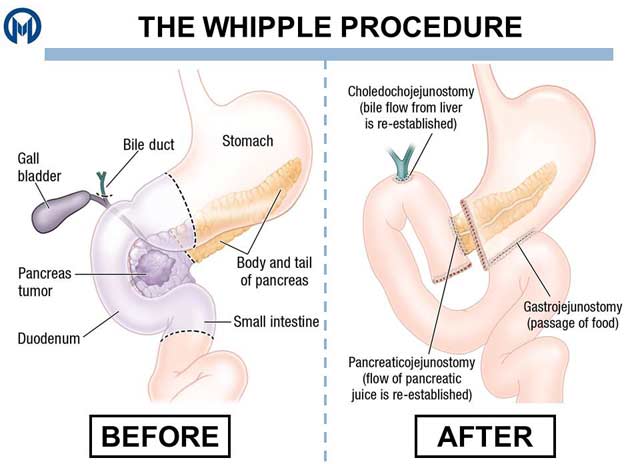Whipple Procedure for Pancreatic Cancer

The most common type of pancreatic cancer surgery, the Whipple procedure is performed to remove localized tumors from the head of the pancreas. The procedure is named after Dr. Allen O. Whipple, the first surgeon to perform a two-stage resection of the first part of the small intestine (duodenum) and head of the pancreas in 1935.
After further refining his surgical techniques, Dr. Whipple later performed a one-stage Whipple procedure in 1940, which became the new standard of care for pancreatic tumors. Over the years, surgeons have continually enhanced the Whipple procedure, leading to better outcomes and quality of life for many pancreatic cancer patients.
What does the Whipple procedure for pancreatic cancer involve?
Also known as pancreaticoduodenectomy, a standard Whipple procedure involves surgically removing:
- The head of the pancreas, which constitutes approximately 50% of the organ
- The duodenum
- The gallbladder
- Part of the common bile duct
- The surrounding lymph nodes
- Approximately 10% of the stomach
- Sections of nearby blood vessels
The goal of this complex surgery is to completely remove the tumor and all surrounding lymph nodes where cancerous cells may have spread. The surgeon will then reconnect the pancreas, common bile duct and small intestine to restore digestive function.
In some cases, the surgeon may utilize a modified surgical approach known as a pylorus-preserving Whipple procedure. This method involves preserving the entire stomach and stomach valve (pylorus) while removing the tumor and other affected structures.
What happens during a Whipple procedure for pancreatic cancer?
Before undergoing a Whipple procedure, the patient will receive general anesthesia to ensure they will remain asleep throughout the surgery, which can take 5-7 hours to complete. A Whipple procedure can be performed using traditional or minimally invasive robotic-assisted surgical techniques.
Traditional Whipple procedure for pancreatic cancer
When performing traditional open Whipple surgery for pancreatic cancer, the surgeon will make a large incision in the abdomen to access, remove and reconstruct the pancreas and other organs and structures affected by cancer.
Robotic Whipple procedure for pancreatic cancer
When performing minimally invasive robotic-assisted Whipple surgery, the surgeon will make several small incisions in the abdomen and complete the procedure using advanced robotic technology, such as the da Vinci® Surgical System.
The da Vinci® Surgical System incorporates several innovative features that allow the surgeon to make smaller, more precise movements during surgery. These features include:
- A high-definition visualization system that will provide the surgeon with highly magnified, three-dimensional (3D) views while operating
- Wristed surgical instruments that can rotate and bend far beyond the capabilities of the human hand
- Robotic technology that will translate the surgeon’s hand movements into smaller, more precise actions
What are the risks and possible complications of a Whipple procedure for pancreatic cancer?
The Whipple procedure for pancreatic cancer is a complex and extensive surgery that carries several risks and potential complications, including:
- Infection – As with any major surgery, there is a risk of infection at the incision site or within the abdomen.
- Excessive bleeding – Significant blood loss can occur during or after the procedure.
- Delayed gastric emptying – After surgery, the stomach may empty its contents more slowly, which can cause nausea and vomiting.
- Pancreatic fistula – Leakage from the surgical connections can lead to the formation of an abnormal connection between the pancreas and another organ.
- Nutritional deficiencies – Difficulty digesting food and absorbing nutrients can result in weight loss and malnutrition.
- Diabetes – Removal of part of the pancreas can affect insulin production, potentially leading to diabetes.
The risk level can vary depending on the patient’s overall health and other factors. To help the patient make fully informed treatment decisions, the surgeon will explain the risks and possible complications of the Whipple procedure for pancreatic cancer.
What to expect during recovery from a Whipple procedure for pancreatic cancer
After undergoing Whipple surgery, the patient will remain in the hospital for 1-2 weeks so they can be closely monitored for signs of surgical complications. During the first few days of recovery, the patient will be restricted from eating solid food.
When the patient is released from the hospital, the surgeon will provide specific post-operative instructions regarding the gradual reintroduction of solid food and physical activity. During the first few months of recovery, the patient will likely feel fatigued and should see gradual improvements in their strength and energy levels over time.
How effective is a Whipple procedure for pancreatic cancer?
The Whipple procedure is an effective surgical treatment for pancreatic cancer, particularly when the tumor is located in the head of the pancreas and has not spread extensively. When performed by an experienced surgeon at a high-volume cancer center, Whipple surgery can lead to the best possible outcome and potentially a cure. That said, the effectiveness of the Whipple procedure for pancreatic cancer can vary based on factors such as the stage of the tumor, the patient’s overall health and the completeness of tumor removal.
Benefit from world-class care at Moffitt Cancer Center
Moffitt is a high-volume cancer center, and this translates to extensive expertise in pancreatic cancer treatment, including Whipple surgery. We also have a robust portfolio of clinical trials, which provides our patients with unique opportunities to be among the first to benefit from promising new therapies that are not yet available in other settings.
If you would like to learn more about the Whipple procedure for pancreatic cancer, you can request an appointment with a specialist in our Gastrointestinal Oncology Program by calling 1-888-663-3488 or submitting a new patient registration form online. We do not require referrals.
Helpful links:
